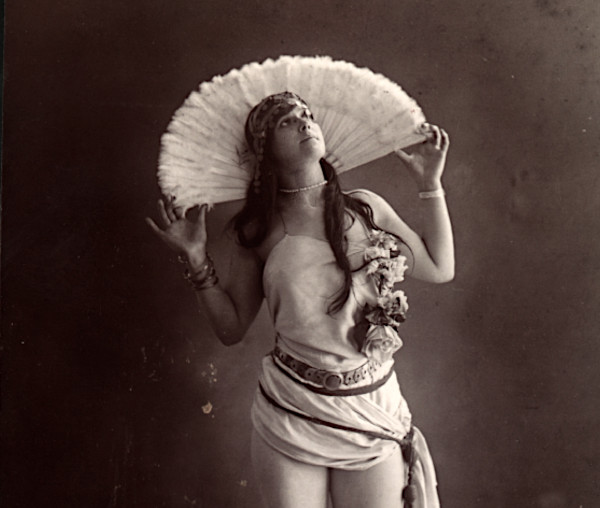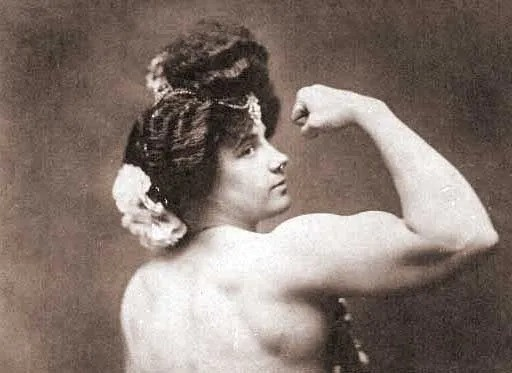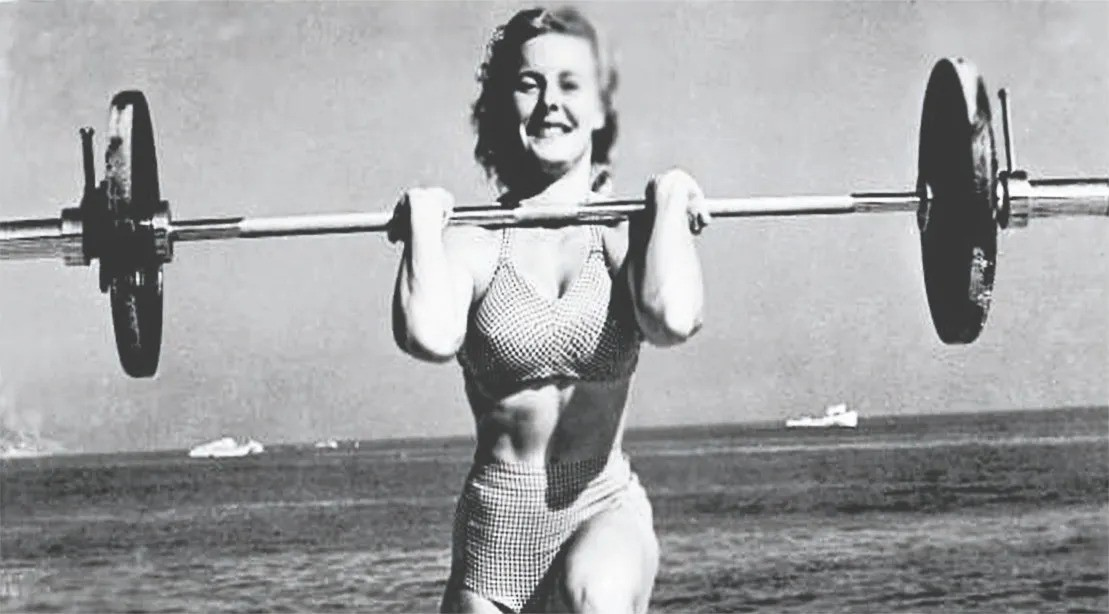From Sidelines to Center Stage: A Celebration of Women's Weightlifting History
It's 2024, and you only have to scroll through Instagram for about 2.4 seconds before you see a photo of a well-toned girl lifting weights in her Gymshark outfit, showcasing her flexibility on a yoga mat, and otherwise keeping fit and healthy.
It's a common occurrence these days, but it didn't always use to be this way.
Let's be honest about women's strength, or sports in general, it hasn't always been easy (hello, sexism, and outdated ideas), but many inspirations paved the way for us to proudly pump iron today.
Safe to say, we've come a long way over the decades, the centuries even, and we wanted to take today to really shine a light on the women who paved the way, allowing modern female fitness to be what it is today.
However, we're doing it in a bit of an interesting way.
It's time to forget all the generic photos of modern ladies daintily lifting tiny dumbbells – let's talk about the seriously strong women who shattered stereotypes in weightlifting!
So, let's dive into the remarkable story of women's weightlifting – it's guaranteed to leave you feeling inspired and a whole lot more grateful for those heavy barbells!
The Early Years and Resistance
It's the late 1800s, corsets are tighter than leg day, and a woman lifting anything heavier than a teapot or serving dinner for her family?
Scandalous, but guess what?
Some seriously strong ladies working hard to break the status quo said, "Watch this," and began flexing their way into the spotlight.
These early strong women weren't just bending iron; they were bending the rigid rules of what society thought women were capable of.
As you can imagine, they weren't the only ones facing an uphill battle – women delving into strength sports have often been met with skepticism and resistance.
Weightlifting, powerlifting, weight training, and bodybuilding competitions for women only began being officially sanctioned in the late 1970s and 1980s, and even the first World's Strongest Woman event didn't happen until 1997.
But they kept at it, and this is a testament to them.
Ladies Who Lift (Heavy Stuff): The Queens of Strength
So, who were these rule-breaking, iron-bending pioneers? Who were those in the history of women in weightlifting sports?
The women who dared to defy expectations and laid the foundation for the way we think about female fitness today?
As above, these ladies weren't just bending the rules – they were shattering them with their incredible strength, so let's take a moment to meet them.
Katie Sandwina
Katie Sandwina, a powerhouse among female athletes of the early 20th century, wasn't just strong – she was a force of nature, shattering gender norms with every feat.
Think lifting 200 pounds overhead? Easy.
Hoisting her husband like a barbell? Nothing more than a casual warmup.
Born 1884, Sandwina was a walking, lifting, muscle-bound rebellion against the idea that women were meant to be delicate, and if you're talking about female weightlifters, she is the one that comes to mind to many.
As was the case back in those days, she was an act in the famous Ringling Bros circus while living in the United States, as well as the Barnum & Bailey Circus, working until she was 60 years old.
During her act, she was known for lifting her husband overhead with one hand, bending pure steel bars, and holding back the pull of four horses at the same time. It's impressive stuff for any strong person.
Her record overhead lift clocked in at an impressive 296 pounds, which wasn't beaten by another female lifted until 1987 - 30 years after Sandwica had passed away.
As the feminist movement roared to life, icons like Sandwina became living proof of women's incredible potential, especially against their male counterparts.
She challenged the idea that male dominance in sports was inevitable. Her influence didn't just ripple through weightlifting records – it shook the very foundations of how society viewed women.
Katie Sandwina's legacy isn't just about her strength; it's about rewriting the rules and carving out space for every single woman who dares to claim her power.
Vulcana: Strong, with a Side of Scandal
In the heart of Britain, a force of nature named Vulcana emerged, a woman who wasn't just strong – she seemed to defy the very laws of physics.
Born Miriam Kate Williams, she became Vulcana, a stage name as bold as her feats of strength, which started out as being the replacement act for a local fete held in Pontypool, Wales, hosted by William Roberts, who ran the local women's gymnasium in 1980.
Due to the sheer popularity of their performances, they dubbed themselves Vulcana and Altas (great names) and started to work shows in London and then the world.
Alongside her partner, Atlas (a man known for a bit of, shall we say, exaggeration), Vulcana captivated audiences across the globe. Sure, Atlas may have stretched the truth a bit, but Vulcana's raw power?
That spoke for itself.
This wasn't just about stage tricks – even the father of French bodybuilding, Edmond Desbonnet, bowed down to Vulcana's might.
Think stopping a runaway horse at just thirteen, daring rescues from raging fires – this woman was real-life superhero stuff.
And get this – even her life offstage was a whirlwind! Alerting police during the notorious Crippen murder case?
Just another day for Vulcana.
Her story isn't just about muscles; it's about scandal, sensation, and a woman who shattered every expectation her era tried to impose.
Vulcana's legacy is about showing the world that strength is beautiful, courage is captivating, and a woman who dares to break the mould? Well, she's absolutely unstoppable.
Minerva: The Strongwoman Pioneer
Minerva, born Josephine Blatt, turned the heads of everyone, not just female lifters, in the late 19th century.
Now, there are varying reports about Blatt. Some say she was born in America, others in Hamburg, Germany. Some place her childhood in Hoboken, Elizabethtown, or New Jersey, so we can't be absolutely sure.
What we can be sure of is her raw lifting strength.
Returning to the July 1937 issue of Strength & Health magazine, journalist Rosetta Hoffman claimed Minerva could lift 23 men on a platform.
This 3,564lbs hip-and-harness lift was then listed in the Guinness Book of World Records for years, despite it contradicting the weight described by the event in which she lifted, which was hosted at the Bijou Theatre.
Now, there was some sensationalism around this event, and it seems in Minerva's life in general, but that's show business. We can be sure that she lifted around 3000 lbs that day, probably around 18 men, which is still an incredible feat, and she won trophies for such events.
Even more impressively, Minerva enjoyed a rather successful career in wrestling, holding the title as the first woman to win a wrestling championship in the US - where she fought both men and other women - a legacy that has stood the test of time.
Every time you see female strength athletes, wrestlers, gladiators, or fighters, understand that it's because of women like Blatt that made it all possible.
Therefore, her legacy isn't just about her; it's about every woman who's ever been told she can't lift, push, or fight her way to the top. Minerva symbolizes defiance, a reminder that true strength has no gender.
Ivy Russell: Breaking New Ground
In the stifling grip of early 20th-century rules, Ivy Russell dared to be different, earning her the title of the World's Strongest Woman during her time. And her journey was anything but easy.
Born a mere three pounds, Ivy suffered a whole host of illnesses and conditions throughout her childhood, was asthmatic, weak, and, by the age of 14, had nearly developed tuberculosis.
However, after seeking the guidance of E.A Ted Streeter, a trainer based in London, who went on to become a life-long friend, they began a journey to change everything.
By 16, Russell had not only overcome and reversed many of her life's ailments and health conditions since birth but could take her strength training to the next level, far beyond that of the average person.
After taking up gymnastics, hand balancing, and boxing, she started gaining some real muscle. So much so that she was able, while still a teenager, to support six other gymnasts while at the bottom of a human pyramid, completely unassisted.
By age 18, she was lifting 176 lbs while only 134 lbs herself, and in 1932, she won a competition against fellow lifter Tillie Tinmouth, lifting 300 lbs overhead.
However, Russell's legacy still lives on to this day. Thanks to her efforts back in 1934, Ivy convinced the British Amateur Weightlifting Association to start granting full memberships and contests for women.
So, if you're ever looking to join and sign up in the UK, remember Ivy Russell was the girl who made it all happen.
Abbye' Pudgy' Stockton: The Face of Female Strength
Don't let the nickname fool you.
Pudgy Stockton was a force to be reckoned with. This 115-pound powerhouse wasn't your average '40s woman. She hoisted her husband overhead like a trophy, muscles rippling on Muscle Beach. Magazine covers were her battleground – gracing over forty; she stood shoulder-to-shoulder with bodybuilding legends.
Her weapon wasn't just iron; it was her pen.
Stockton's "Barbells" column stormed the pages of Strength & Health, a beacon for women daring to be strong. But talk wasn't enough. In 1947, Stockton didn't just compete; she built the stage, organizing America's first female weightlifting showdown, known as the Amateur Athletic Union-sanctioned weightlifting competition for women held in 1947.
She lifted, she led, she conquered.
Of course, back then, there weren't many women weightlifting competitions around, and only really a few women to compete, meaning the only title she secured was the "Miss Physical Culture Venus" in 1948.
However, she was admitted into the IFBB Hall of Fame in 2000, celebrating her work and accomplishments, which she got to see before passing away in 2006.
A beautiful journey, one where she actually was able to see how the industry evolved over her lifetime, which has since led to women's Olympic weightlifting events in the Olympic Games, among other popular female strength sports that are now held all over the world..
Strong Women 2.0: From Sideshows to Superstars Evolution and Growth: Adaptation To Modern Trends
The awesome thing about strength is that it's constantly evolving, and the women who embody it are no different!
Gone are the days when strong women were mostly seen as sideshow acts. Today, they're respected athletes with official competitions where they can crush records and inspire the world.
It's not just about raw power anymore, either. The modern strongwoman is a total fitness queen!
Sure, she can squat a house, but she also knows that fueling her body right and caring for her mental game is just as important.
Think less "circus strong," more "total wellness warrior."
This shift means women's strength and weight sports are only getting bigger and better. We see powerlifting champs, CrossFit superstars, and everyday women hitting the gym to get strong for life, not just for likes.
The legacy of those early pioneers lives on, and honestly, the future of female strength has never looked brighter.
Celebrating Six Years of the Mobility MVMNT Movement
Let's be honest – building a successful health and wellness movement isn't all smooth sailing. It's sweat, hustle, and sometimes a few heart-wrenching detours. Celebrating milestones, those big and small victories? That's what keeps the fire burning.
And a little gratitude for the people that fuel your journey? Well, that's the good stuff!
Crystal, our fearless founder, set sail on this adventure six years ago, not as some side gig – this was born from her burning desire to help others live healthier, happier, MOVE BETTER.
The early days were pure hustle (hello, questionable lighting setups!). But things took flight in 2019 with the Mobility MVMNT App – hundreds of classes for everyone, from hardcore athletes to those who struggle to touch their toes.
This is our game-changer!
We're not just fancy stretches – we're about grit, overcoming those "how the heck?" moments, and a community that makes us better each day.
We're standing for what the women of our past have stood for - defying expectations, changing the game, and having fun in the process.
Growth, Change, Gratitude
Like our members, we've evolved. Starting with a "rip heavyweights" mentality, life threw Crystal a curveball. We learned it's not just about pushing limits – it's about what your body CAN do.
Mobility, breathwork, mindfulness – they're woven into what we do now. We all need a reset sometimes, right?
Six years is a HUGE milestone, worthy of major celebration! But we're most grateful for our incredible community, our dedicated team, and those every day wins our members achieve.
Here's to the future! Think killer new programs, a super-slick app, and maybe some real-life meetups!
In year six, we're filled with gratitude for YOU, our Mobility MVMNT crew, from powerhouses to those taking their first steps.
Conclusion
Whether it's bending steel bars or bending the rules, women in strength sports have always been about resilience, growth, and changing the game.
We've come a long way, and it's thanks to the pioneers, the champions, and our incredible community that keeps pushing the boundaries.
Let's raise a metaphorical protein shake to celebrate how far we've come and all the amazing things we still need to achieve.
The future is bright, the future is strong, and we can't wait to see what women everywhere will lift, build, and conquer next!













